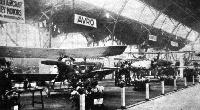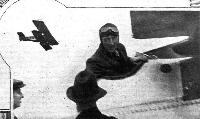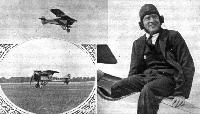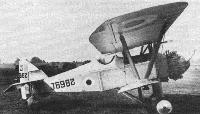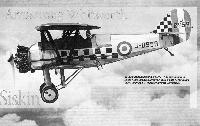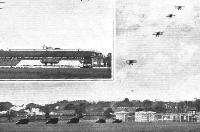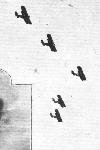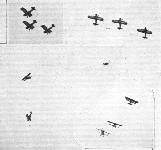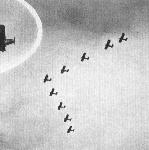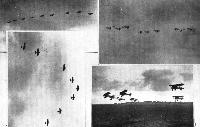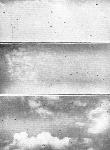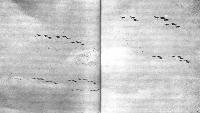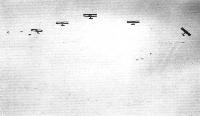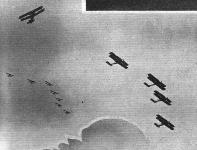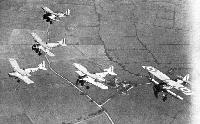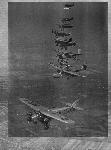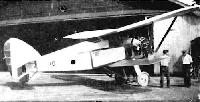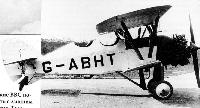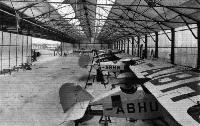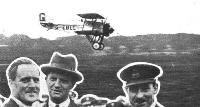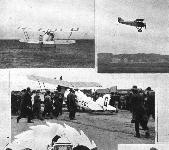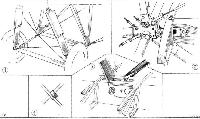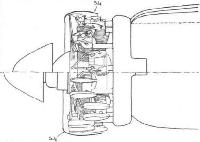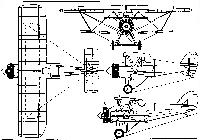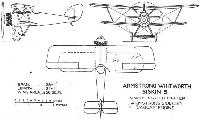
Варианты
- Armstrong Whitworth (Siddeley) - S.R.2 Siskin - 1919 - Великобритания
- Armstrong Whitworth - Siskin - 1921 - Великобритания
Armstrong Whitworth Siskin
Изначально известный как Siddeley Deasy S.R.2 Siskin, самолет был построен в 1919 году дочерним предприятием "Armstrong Whitworth". Самолет проектировался с прицелом на то, чтобы стать основным истребителем британских ВВС с середины 1920-х годов. Машина проектировалась под звездообразный мотор мощностью 300 л.с создававшийся вначале в Фарнборо на 8-м авиазаводе, а потом - специалистами фирмы "Siddeley Deasy". Однако из-за того, что компания больше времени уделяла программе двигателя Puma, первый полет S. R.2 выполнил с 320-сильным мотором ABC Dragonfly. Хотя аппарат показал хорошие летные характеристики, двигатель работал ненадежно, что потребовало установки мотора Armstrong Siddeley Jaguar мощностью 325 л.с. Первый из трех прототипов истребителя Siskin поднялся в воздух в марте 1921 года уже под маркой "Armstrong Whitworth".
Новая политика Министерства авиации, которое решило заказывать только цельнометаллические самолеты, побудила конструкторов "Armstrong Whitworth" переделать самолет. После постройки нескольких машин смешанной деревянно-металлической конструкции, в мае 1923 года в воздух поднимается цельнометаллический Siskin Mk III. За опытной машиной последовала предсерийная партия из трех самолетов, первый из которых поднялся в воздух спустя 10 месяцев после прототипа.
Рекламное турне по Европе принесло заказ на 65 истребителей от Румынии - первый самолет из этой партии поднялся в воздух в октябре 1924 года, до конца года заказчик получил еще шесть машин, но дальнейшие поставки были аннулированы из-за катастрофы истребителя Siskin в Румынии.
Первые истребители Siskin Mk III поступили на вооружение 41-й британской авиаэскадрильи в мае 1924 года (авиабаза Нортхолт), а в следующем месяце новую технику получила 111-я эскадрилья - самолеты Siskin пришли на смену истребителям Sopwith Snipe. Всего было построено 465 истребителей Siskin Mk III, включая несколько двухместных самолетов. Эстония. Канада и авиашкола фирмы "Armstrong Whitworth" получили двухместные учебно-тренировочные варианты истребителя, тогда как британские ВВС получили несколько новых двухместных самолетов, а затем переоборудовали в УТС дополнительное количество машин.
Лучшим стал вариант Siskin Mk IIIA, в прототип которого переделали серийный Siskin Mk III (первый полет - октябрь 1925 года). Значительного увеличения летных характеристик удалось добиться за счет установки двигателя Armstrong Siddeley Jaguar IV. Для британских ВВС построено 387 самолетов Siskin Mk IIIA, включая 47 учебно-тренировочных машин с двойным управлением. Большинство, за исключением 135 самолетов, были изготовлены субподрядчиками - "Bristol" (84 машины), "Gloster" (74), "Vickers" (52) и "Blackburn" (42).
Новой модификацией в сентябре 1926 года первой перевооружили 111-ю эскадрилью, за которой последовали еще 10 эскадрилий. Процесс снятия самолетов с вооружения начался в 56-й эскадрилье, получившей самолеты Bristol Buldog в октябре 1932 года. По результатам испытаний двух самолетов Siskin Mk III канадские ВВС заказали партию из 12 Siskin Mk IIIA, поставленных в 1926-1931 годах (частично это были новые истребители, остальные - снятые с вооружения британских ВВС). Истребители Siskin в 1-й истребительной эскадрилье канадских ВВС были заменены в 1 939 году самолетами Hawker Hurricane, но оставались на хранении до 1947 года.
Модификации
S.R.2 Siskin: три самолета, построенные "Siddley Deasy Motor Car Со."
Siskin Mk II: гражданский прототип (первый полет в 1923 году), летал в одно- и двухместном вариантах
Siskin Mk III: цельнометаллическая серийная модификация (построено 64 самолета, все - для британских ВВС) с ПД Armstrong Siddeley Jaguar III мощностью 325 л.с; максимальная скорость на высоте 1980 м - 216 км/ч время набора высоты 1980 м - 5 мин, практический потолок 6250 м, продолжительность полета 3 ч, масса пустого 830 кг, максимальная взлетная масса 1241 кг. размах крыла 10,08 м, длина 7.01 м, высота 2.95 м, площадь крыла 27,22 м'
Siskin Mk IIIA: основная серийная модификация (построено 340 и 12 самолетов для ВВС Великобритании и Канады соответственно)
Siskin Mk IIIB: единственный прототип с мотором Jaguar VIII и редуктором, позволяющим набирать высоту 4570 м за 11 мин 30 с. на 2 мин меньше, чем Siskin Mk IIIA; на этой высоте Siskin Mk IIIB развивал примерно на 32 км/ч большую скорость; взлетная масса увеличена на 104 кг; летчики из Мартлсхэм Хит, однако, отметили сложность его пилотирования и сократившуюся до 1 ч продолжительность полета при полном газе.
Siskin Mk IIIDC: двухместный учебно-тренировочный самолет с двойным управлением, предназначенный для Центральной авиационной школы, училища Королевских ВВС Великобритании, а также для 3-й и 5-й авиашкол; некоторое количество самолетов поступило в эскадрильи, вооруженные истребителями Siskin (всего построено 53 самолета, 47 для британских ВВС, два для Канады, два для AST и два для Эстонии)
Siskin Mk IV: единственный гражданский вариант, разработанный для участия в гонках 1925 года за Кубок Короля; спроектирован на базе Siskin Mk V, но с крылом уменьшенного размаха
Siskin Mk V: гражданский вариант, разработанный для Румынии; построено только две машины, использовавшиеся в гонках; конструкция - деревянно-металлическая, нижнее крыло двухлонжеронное; Ф.Л. Барнард на Siskin Mk V выиграл в 1925 году гонку за Королевский кубок, развив скорость более 243 км/ч
ТАКТИКО-ТЕХНИЧЕСКИЕ ХАРАКТЕРИСТИКИ
Armstrong Whitworth Siskin Mk IIIA
Тип: одноместный истребитель
Силовая установка: один звездообразный двигатель Armstrong Siddeley Jaguar IV мощностью 420 - 450 л.с.(313-336 квт)
Характеристики: максимальная скорость на уровне моря 251 км/ч; время набора высоты 4570 м- 10 мин 30 с; практический потолок 8230 м; продолжительность полета на режиме полного газа 1 ч 12 мин
Масса: пустого 935 кг; максимальная взлетная 1366 кг
Размеры: размах крыла 10.11 м; длина 7,72 м; высота 3.10 м; площадь крыла 27.22 м'
Вооружение: два неподвижных пулемета калибра 7,7 мм и до 36 кг бомб на подкрыльевых держателях
Описание:
- Armstrong Whitworth Siskin
- Flight, December 1924
The Paris Aero Show 1924
Фотографии
-
Мировая Авиация 54
Регистрационный номер: J7152 [2] J-7152. Один из партии в 35 самолетов Mk III, заказанных Королевскими ВВС. Данный тип самолетов находился на вооружении 111 -й эскадрильи "Treble One", базировавшейся в Даксфорде с июня 1924 по ноябрь 1926 года - до перевооружения на самолеты модификации Mk IIIA.
-
Мировая Авиация 54
Регистрационный номер: J8834 [2] J-8834. Изображен самолет из первой партии в 42 машины, построенной "Bristol Aeroplane Company". Он несет отличительные красные полосы 1-й эскадрильи, эксплуатировавшей самолет с февраля 1927 по февраль 1932 года.
-
Air Enthusiast 1971-09 / R.Braybrook - Biplane Era: The Flight from Reality /Fighters in the RAF/ (1)
Регистрационный номер: J8959 [4] Armstrong Whitworth Siskin IIIA of No 43 Squadron (1929).
-
Aeroplane Monthly 1978-02 / R.Williams - The Siskin saga (1)
Регистрационный номер: G-ABHT [3] Armstrong Whitworth Siskin IIIDC of Air Service Training Hamble, crashed near Botley Hants 8/6/31.
-
Aeroplane Monthly 1991-02 / O.Thetford, A.Lumsden - On silver wings (5)
Регистрационный номер: G-EBHY [2] The second Siskin II, G-EBHY, gained its C of A on June 25,1924. It eventually went to Sweden, where it flew with an experimental ski undercarriage.
-
Flight 1924-08 / Flight
Регистрационный номер: G-EBEU [5] THE RACE FOR THE KING'S CUP: Ten of the faster machines, arranged in the order of starting: 10, Siddeley Siskin, with 350 h.p. Siddeley "Jaguar" engine.
-
Aeroplane Monthly 1991-02 / O.Thetford, A.Lumsden - On silver wings (5)
Регистрационный номер: G-EBEU [5] Siskin II G-EBEU competed in the 1922 King's Cup air race and was flown by Frank Courtney, but had to retire when a centre-section fitting broke shortly after leaving Glasgow.
-
Aeroplane Monthly 1978-02 / R.Williams - The Siskin saga (1)
Регистрационный номер: G-EBEU [5] Siskin II G-EBEU in its original, two-seater form, as flown in the 1922 King’s Cup Air Race
-
Flight 1922-09 / Flight
Filling up Courtney's Siddeley "Siskin" before the start.
-
Flight 1923-07 / Flight
THE KING'S CUP: The Siddeley "Siskin," Courtney's winning mount, "on view" after the race.
-
Flight 1923-08 / Flight
BRITAIN AT I.L.U.G.: This set of photographs, kindly supplied by the S.B.A.C., shows some of the British exhibits at the Gothenburg International Aero Exhibition, which has just closed. The Siddeley Siskin Mark II, with Siddeley "Jaguar."
-
Flight 1924-06 / Flight
A CORNER OF THE BRITISH EXHIBIT AT PRAGUE: In the foreground the Armstrong-Whitworth "Siskin," with Siddeley "Jaguar" engine.
-
Flight 1924-08 / Flight
The Armstrong-Whitworth "Siskin," piloted by Flight Lieut. Jones, made the fastest time. Our photo, shows one of the large petrol tanks, and the "Jaguar" engine.
-
Aeroplane Monthly 1978-02 / R.Williams - The Siskin saga (1)
Регистрационный номер: J6583 [2] The first all-metal Siskin, J6583, at Martlesham Heath in 1923.
-
Мировая Авиация 54
Регистрационный номер: J6583 [2] В то время запуск двигателя обычно производился с помощью стартера Хакса. На фотографии Siskin Mk III перед запуском с прикрепленным к втулке воздушного винта валом стартера.
-
Flight 1926-04 / Flight
Hot or cold! The extraordinary success with which the Armstrong-Siddeley "Jaguar" air-cooled engine functioned at temperatures in the neighbourhood of 110°F. during Cobham's recent London - Cape Town flight is still fresh in everyone's mind. The accompanying illustration is therefore particularly interesting inasmuch as it shows that this remarkable engine is equally at home at the other extreme. It depicts an "A.-W. Siskin" on which Lieut. Luneberg, of the Swedish Flying Corps, made a successful test in the far north of Sweden, with a temperature below 60 of frost, and then made a flight of 800 miles to the south of Sweden.
-
Flight 1923-07 / Flight
THE TWO SIDDELEY "JAGUAR"-ENGINED MACHINES READY TO GET AWAY: Left, the Gloucestershire "Grebe," the scratch machine, and, right, Mr. J.D.Siddeley's "Siskin," which was piloted to victory by Mr. Frank T. Courtney.
Другие самолёты на фотографии: Gloster Grebe - Великобритания - 1923
-
Flight 1923-07 / Flight
THE KING'S CUP: The last three away. From right to left, Mr. George Robey's D.H.9 (450 Napier "Lion"), flown by Mr. A. J. Cobham, who came in second; Mr. J. D. Siddeley's Siddeley "Siskin" (325 Siddeley "Jaguar"), piloted by Mr. Frank T. Courtney, in whom was found the winner; Sir William Joynson-Hicks' Gloucestershire "Grebe" (325 Siddeley "Jaguar"), flown by Mr. L. L. Carter. This entry was the scratch machine.
Другие самолёты на фотографии: De Havilland D.H.9 - Великобритания - 1917Gloster Grebe - Великобритания - 1923
-
Flight 1922-09 / Flight
Регистрационный номер: G-EBEU [5] SOME OF THE STARTS FOR THE KING'S CUP RACE: Courtney zooms off in a left-hand turn on the Siddeley Siskin.
-
Flight 1924-08 / Flight
Регистрационный номер: G-EBEU [5] THE SECOND KING'S CUP RACE, 1923: F. C. Courtney seated in the Siddeley "Siskin" (Siddeley "Jaguar") after the winning of the King's Cup Race. Inset, the "Siskin" crossing the line.
-
Aeroplane Monthly 1978-02 / R.Williams - The Siskin saga (1)
Регистрационный номер: G-EBJS [4], J6982 [4] The other Siskin for the 1924 King’s Cup was G-EBJS, flown by Frank Courtney. Carburettor icing forced it down at Brough.
-
Aeroplane Monthly 1991-02 / O.Thetford, A.Lumsden - On silver wings (5)
Регистрационный номер: G-EBJS [4], J6982 [4] Siskin III G-EBJS also took part in the 1924 King's Cup. Piloted by Frank Courtney, it suffered a broken spinner and had to retire from the race at Brough.
-
Aeroplane Monthly 1978-02 / R.Williams - The Siskin saga (1)
Регистрационный номер: G-EBJQ [3] Probably built specifically for the 1924 King’s Cup Race, G-EBJQ, flown by Flt Lt H. W. G. Jones, finished in fourth place.
-
Aeroplane Monthly 1991-02 / O.Thetford, A.Lumsden - On silver wings (5)
Регистрационный номер: G-EBJQ [3] Самым известным из гражданских вариантов самолета был, вероятно, G-EBJQ - гражданский Mk III, выигравший в 1925 году гонки на Королевский кубок, показав скорость 243,7 км/ч.
Siskin II G-EBJQ, fitted with extra fuel tanks under the upper wing, competed in the 1924 King's Cup air race. It was placed fourth. -
Flight 1924-08 / Flight
Регистрационный номер: G-EBJQ [3] THE FASTEST MACHINE IN THE KING'S CUP RACE: The two photographs on the left show the Armstrong-Whitworth "Siskin," which was fourth under the handicap, crossing the finishing line, and, below, alighting on the Gosport aerodrome. On the right Flight-Lieut. Jones getting out of his machine.
-
Flight 1930-01 / Flight
Flight-Lieut. Jones in a Siskin doing the fastest time in the King's Cup Race of 1924.
-
Air Enthusiast 1972-02 / Fighter A to Z (9)
Регистрационный номер: J6982 [4], G-EBJS [4] The second production Siskin III for the RAF. This model possessed little commonality with the Siskin II.
-
Aeroplane Monthly 1991-02 / O.Thetford, A.Lumsden - On silver wings (5)
Регистрационный номер: J6982 [4], G-EBJS [4] Siskin Mk III J6982 was delivered to the A&AEE in November 1923 and the RAE in March the following year. In July 1924 the Siskin was registered G-EBJS for participation in the year's King's Cup race and returned to RAF service in November.
-
Aeroplane Monthly 1978-02 / R.Williams - The Siskin saga (1)
Регистрационный номер: J6999 J6999 was from the second batch of Siskin IIIs for the RAF.
-
Aeroplane Monthly 1991-02 / O.Thetford, A.Lumsden - On silver wings (5)
Регистрационный номер: J7000 Siskin Mk III J7000 was delivered to the A&AEE and the RAE during the latter part of 1924. It was converted into a dual trainer and subsequently flew with Nos 22 and 1 Sqns.
-
Aeroplane Monthly 1978-02 / R.Williams - The Siskin saga (1)
Регистрационный номер: J7002 [2] Another example of a Siskin III, J7552 carries the black bar insignia of 111 Squadron.
-
Aeroplane Monthly 1991-03 / O.Thetford, A.Lumsden - On silver wings (6)
Регистрационный номер: J7002 [2] Siskin III J7002 was delivered to 41 Sqn in January 1924 and subsequently saw service with Nos 19 and 111 Squadrons before relegation to Nos 3 and 5 FTS. It was finally taken off RAF charge in April 1933.
-
Aeroplane Monthly 1978-03 / R.Williams - The Siskin saga (2)
Регистрационный номер: J7148 [4] Siskin III J7148 before the trial fitment of a fully-enclosed cowling in 1925.
-
Aeroplane Monthly 1991-02 / O.Thetford, A.Lumsden - On silver wings (5)
Регистрационный номер: J7148 [4] Siskin III J7148 was first flown in May 1924 and, following tests with A&AEE fitted with enclosed cowlings, was later converted into a dual-control trainer. On January 27, 1928 J7148 tipped onto its nose at RAF Eastchurch and was subsequently struck off RAF charge.
-
Aeroplane Monthly 1991-02 / O.Thetford, A.Lumsden - On silver wings (5)
Регистрационный номер: J7148 [4] Another photograph of Siskin III J7148, showing the experimental cowlings enclosing the Jaguar II radial engine.
-
Aeroplane Monthly 1978-03 / R.Williams - The Siskin saga (2)
Регистрационный номер: J7148 [4] Siskin III J7148 after the trial fitment of a fully-enclosed cowling in 1925.
-
Aeroplane Monthly 1988-05 / Personal album. Military
Регистрационный номер: J7152 [2] Armstrong Whitworth Siskin III J7152 first flew on May 28, 1924, and joined 111 Sqn at Duxford the following month. It subsequently served with 41 Sqn, and in June 1926 was converted into a two-seat trainer. Powered by a 325 h.p. Armstrong Siddeley Jaguar III 14-cylinder radial engine, it was armed with twin Vickers machine-guns.
-
Aeroplane Monthly 1991-03 / O.Thetford, A.Lumsden - On silver wings (6)
Регистрационный номер: J7155 Siskin III J7155 was first flown in June 1924 and was delivered to 111 Squadron. It later passed to 41 Sqn and on May 6t 1926 was damaged following engine failure while taking off from RAF Northolt.
-
Aeroplane Monthly 1991-02 / O.Thetford, A.Lumsden - On silver wings (5)
Регистрационный номер: J7161 Siskin Mk III J7161 was first flown in June 1924 and was later fitted with a Jaguar IVS engine. Later still it was converted to dual control and ended its days with Nos 3 and 5 FTSs.
-
Aeroplane Monthly 1978-03 / R.Williams - The Siskin saga (2)
Регистрационный номер: J7176 Siskin IIIA J7176 whilst on detachment to Ambala for demonstration to the Indian Government.
-
Aeroplane Monthly 1991-03 / O.Thetford, A.Lumsden - On silver wings (6)
Регистрационный номер: J7178 Siskin III J7178 was first flown in October 1924. After this photograph was taken the aircraft was converted to a Mk IIIA and delivered to 41 Sqn. Its later life was spent with 5 FTS.
-
Aeroplane Monthly 1978-03 / R.Williams - The Siskin saga (2)
Регистрационный номер: J7764 Siskin III J7764 of 41 Squadron, based at Northolt.
-
Aeroplane Monthly 1991-02 / O.Thetford, A.Lumsden - On silver wings (5)
Регистрационный номер: J8048 Siskin IIIA J8048 was the first production aircraft and was first flown in October 1925. It was delivered to 111 Squadron in September the following year, and ended its days flying with the Duxford Met Flight.
-
Flight 1927-06 / Flight
Регистрационный номер: J8386 [3] THE SIR PHILIP SASSOON CUP RACE AT NORTHOLT: An Armstrong-Whitworth "Siskin 3A" is here shown starting for the race.
Another 41 Squadron Siskin was J8386, seen here at its Northolt base during the Sassoon Cup race on May 26, 1927, piloted by Fg Off H. T. Andrews. -
Aeroplane Monthly 1991-03 / O.Thetford, A.Lumsden - On silver wings (6)
Регистрационный номер: J8386 [3] Fg Off H. T. Andrews competing in the Sir Philip Sassoon Cup at RAF Northolt on May 26, 1927 in 41 Sqn Siskin IIIA J8386. He was placed fourth in the race, averaging 142 m.p.h. for the 100-mile course, which started at Northolt and returned there via Duxford and Halton.
-
Aeroplane Monthly 1991-03 / O.Thetford, A.Lumsden - On silver wings (6)
Регистрационный номер: J8390 Siskin IIIA J8390 pictured aboard the battle cruiser HMS Repulse during weathering tests in 1929.
-
Aeroplane Monthly 1978-03 / R.Williams - The Siskin saga (2)
Регистрационный номер: J8428 [3] The unmarked prototype Siskin IIIA, c/n AW 160, at Martlesham Heath during trials in 1926, prior to becoming J8428.
-
Aeroplane Monthly 1978-03 / R.Williams - The Siskin saga (2)
Регистрационный номер: J8428 [3] The prototype Siskin IIIA J8428 fitted with heater muff on the engine exhaust, after delivery to Farnborough in June 1927. First flown in October 1925, this Siskin spent much of its life to-ing and fro-ing between the RAE and its makers. It finally ended up at Wingletyne Yard, Hornchurch, where it was broken up in April 1933.
-
Air Enthusiast 1971-09 / R.Braybrook - Biplane Era: The Flight from Reality /Fighters in the RAF/ (1)
Регистрационный номер: J8428 [3] The Armstrong Whitworth Siskin IIIA replaced the Grebe in many squadrons, serving with a total of 11 RAF units. With its uncowled radial engine and twin 0 303-in machine gun armament it was entirely typical of the 'twenties.
-
Aeroplane Monthly 1991-02 / O.Thetford, A.Lumsden - On silver wings (5)
Регистрационный номер: J8623 Siskin IIIA J8623 was first flown in August 1927. It was delivered to 56 Sqn in November that year.
-
Мировая Авиация 33
Регистрационный номер: J8627 [2] "Armstrong Whitworth" разработала модификацию Siskin Mk IIIB с более мощным мотором для замены истребителей Siskin Mk IIIA, но в серийное производство данный вариант не передавался.
The experimental Siskin IIIB which featured a Townend ring cowling and uprated Jaguar engine. This improved version was not particularly liked by Martlesham Heath pilots and the variant was not put into production. -
Aeroplane Monthly 1978-03 / R.Williams - The Siskin saga (2)
Регистрационный номер: J8627 [2] Begun as a Siskin IIIA, J8627 was converted on the production line to become the sole Siskin IIIB, with Townend ring and rear fuselage refinements. The Bulldog succeeded the Siskin IIIA in the RAF.
-
Aeroplane Monthly 1978-05 / ??? - Vintage Siskin Colour
Регистрационный номер: J8655 [2] Armstrong Whitworth Siskin IIIA J8655 on No 41 Squadron, RAF, at Hendon in 1929.
-
Aeroplane Monthly 1978-05 / ??? - Vintage Siskin Colour
Регистрационный номер: J8655 [2] Well-protected in his electrically-heated flying suit, a pilot prepares for a flight in J8655, probably with Duxford's Met Flight.
-
Aeroplane Monthly 1978-05 / ??? - Vintage Siskin Colour
An oxygen test prior to a met flight from Duxford.
-
Aeroplane Monthly 1980-09 / P.Heath - Underneath the Arches
Регистрационный номер: J8834 [2] "SISKIN" v. "GAMECOCK": The Armstrong-Whitworth "Siskin IIIa" (supercharged "Jaguar") piloted by Sqdr.-Ldr. E. O. Grenfell (Tangmere)
Bristol-built Siskin IIIA J8834 takes off from Northolt during the Sassoon Cup Race on May 28, 1929, piloted by Sqn Ldr E. O. Grenfell of 1 Sqn. Note the red squadron marking along the fuselage side. The significance of the marking beneath the cockpit is not known - can any reader help? -
Aeroplane Monthly 1991-03 / O.Thetford, A.Lumsden - On silver wings (6)
Регистрационный номер: J8901 A line-up of 19 Sqn Siskin IIIAs - an Avro 504N may be seen in the background.
Другие самолёты на фотографии: Avro Avro 504N - Великобритания - 1920
-
Aviation Historian 19 / P.Jarrett - The Hornet dilemma
Регистрационный номер: J8954 A typical Siskin IIIa, J8954 was built under subcontract by Gloster Aircraft Co Ltd and served with No 41 Sqn from February 1928. The engine was a 450 h.p. Armstrong Siddeley Jaguar IV air-cooled radial. Although a rugged and dependable fighter, the Siskin lacked streamlining when compared to the Hornet/Fury, as is obvious here.
-
Flight 1930-09 / Flight
Регистрационный номер: J8959 [4] 43-я эскадрилья была в числе 11 подразделений, летавших на Siskin. Этот J-8959 и еще 73 машины были построены "Gloster Aircraft Company".
In spite of its uncowled engine, fixed undercarriage, open cockpit and externally braced wings, the Armstrong Whitworth Siskin was regarded in its day (introduced in 1924) as a high performance fighter. This particular aircraft (J-8959) is a Siskin IIIA of 43 Squadron. It displays an unusual wing arrangement in that the top wing had three times the area of the lower wing. -
Flight 1929-05 / Flight
Регистрационный номер: J9312 THE SASSOON CUP. The line-up of Siskins and Gamecocks representing 12 Fighter Squadrons.
Другие самолёты на фотографии: Gloster Gamecock - Великобритания - 1925
-
Aeroplane Monthly 1980-10 / M.Daunt - Tryst or bust
Регистрационный номер: J9363 THE ARMSTRONG WHITWORTH "SISKIN": The first S.S. Fighter of all-metal construction, the "Siskin" is used in greater numbers than any other machine of its class. The engine is a "Jaguar."
-
Aeroplane Monthly 1991-03 / O.Thetford, A.Lumsden - On silver wings (6)
Регистрационный номер: J9895 [2] Siskin IIIA J9895 of 56 Sqn.
-
Air Pictorial 1957-03 / R.Cross - The A.W.Siskin
R.A.F. Siskin III single-seat fighter, first service version;
-
Flight 1927-06 / Flight
Armstrong Whitworth "Siskin'' (Armstrong Siddeley "Jaguar") This is a single-seater fighter which, in the Service type, has reached Series III, and experimentally even higher series numbers. Without going into details it may be said that the machine is produced both in wood and metal. Variations of the type have taken part with success in the King's Cup Race, and yet another version was exhibited at the last Paris Aero Show. The squadrons which are equipped with this machine are No. 41 (Fighter) Squadron. Northolt, and No. 111 (Fighter) Squadron, Duxford, Cambridge. The machine is a biplane characterised by a large top plane and a small bottom plane.
-
Air Pictorial 1957-03 / R.Cross - The A.W.Siskin
Siskin IIIA of No. 32 Squadron.
-
Flight 1928-07 / Flight
BATTLING AT HENDON: Armstrong-Whitworth "Siskins," belonging to the flight which won the Battle Flight Competition, taxi-ing along the enclosures after victory.
-
Flight 1928-08 / Flight
NO.32 (FIGHTER) SQUADRON IN ACTION: Above, three Armstrong-Whitworth "Siskins" returning from a patrol. Below, a squadron of "Siskins" ready for the fray.
-
Flight 1927-07 / Flight
THE MORNING'S PROGRAMME: 4, Start of the altitude race between "Gamecocks" and "Siskins."
Другие самолёты на фотографии: Gloster Gamecock - Великобритания - 1925
-
Flight 1928-07 / Flight
DISPLAY FEATURES: Armstrong-Whitworth "Siskins" (Jaguars) diving in line ahead formation to open fire on the enemy transports crawling over the aerodrome.
-
Flight 1929-09 / Flight
Siskin manoeuvrings: The R.A.F.'s part in the meeting.
-
Aeroplane Monthly 1991-03 / O.Thetford, A.Lumsden - On silver wings (6)
Siskins appeared at all the 1927-1931 RAF Pageants at Hendon. In 1930, 43 Sqn gave a display of tied-together formation aerobatics.
-
Flight 1929-05 / Flight
Armstrong Whitworth "Siskins" ("Jaguars") of No. 29 (Fighter) Squadron zooming.
-
Flight 1929-05 / Flight
THE SASSOON CUP. The finish, showing Flight-Lieut Lea-Cox, No. 56 Sqdn. (left), and Flying Officer Clarke, No. 29 Sqdn. (right), both on Siskins, with but 2 seconds "between them."
-
Flight 1930-08 / Flight
One of the R.A.F. fighter flights half-way up a loop in formation.
-
Flight 1928-11 / Flight
Montreal Air Meeting: General views at Montreal aerodrome on October 1, when 43 machines, including many D.H. "Moths," took part. The machines in formation are Armstrong-Whitworth "Siskins" which gave an excellent demonstration.
-
Flight 1925-07 / Flight
FIGHTING TACTICS AT THE R.A.F. DISPLAY: In Event No.9 a demonstration of flight evolutions in aerial attack was given by three Siddeley ''Siskins'' (No. 41 Fighter Squadron), three Gloucestershire "Grebes" (No. 32 Fighter Squadron), and two Bristol Fighters (No.24 Communication Squadron), In the picture some of the "Siskins" and "Grebes" are seen opening the attack on one of the Bristol Fighters.
Другие самолёты на фотографии: Bristol F.2A/F.2B Fighter - Великобритания - 1916Gloster Grebe - Великобритания - 1923
-
Flight 1928-07 / Flight
BLACKPOOL AIR PAGEANT: Armstrong-Whitworth "Siskins," single-seater fighters, circling the aerodrome in follow-my-leader style.
-
Flight 1927-06 / Flight
A DRESS REHEARSAL: Our picture shows a formation of Siskins from No. 41 Squadron, led by Sq.-Ldr. F. Sowrey, practising, at Hendon, the "Musical Flight," which will form one of the features of the Royal Air Force Display on July 2. The band plays popular airs, which are transmitted by wireless to the pilots up above, who execute various evolutions to the music.
-
Flight 1927-07 / Flight
EVENT NO. 3: Air Manoeuvres to Music. In the upper photograph: "Here we go round the Mulberry Bush." On the left: "Chick, Chick, Chicken." Unfortunately, the "eggs" were white, and do not show against the sky. Below: Returning to the tune of "Bill Bailey, will you please come home." The machines are Armstrong-Whitworth "Siskins" from No. 41 (Fighter) Squadron.
-
Flight 1928-08 / Flight
THE HALTON PAGEANT: A flight of "Siskins" machine-gunning the "native tribe."
-
Aeroplane Monthly 1974-09 / ??? - Hendon Pageantry 1920-37
A.W. Siskins diving on the 1930 Hendon Pageant.
-
Flight 1928-10 / Flight
THE R.A.F. DISPLAY FOR A SULTAN: On October 11 the R.A.F. gave a Display at Hendon in honour of the Sultan of Muscat. Our illustration shows No. 29 Fighter Squadron at Drill.
-
Flight 1930-10 / Flight
THE "PRINCE OF WALES FEATHERS": Siskins of No. 43 Squadron, commanded by Sq.-Ldr. C. N. Lowe, breaking the cords with which they were tied together during the earlier part of their display of formation flying.
-
Flight 1930-09 / Flight
The Siskins of No. 43 F.S. in Flights Astern, stepped up.
-
Aviation Historian 19 / P.Jarrett - The Hornet dilemma
Siskin IIIAs of 43 Squadron, based at Tangmere, photographed in August 1930 in tied-together trios for the 1930 RAF Display at Hendon. They would be replaced by Hawker Furies in 1931.
-
Air Pictorial 1988-01 / J.Rawlings - No.29 Squadron - First with Tornado F.3
Nine No. 29 Squadron Armstrong Whitworth Siskin IIIAs operating from North Weald
-
Flight 1930-09 / Flight
The unique picture above shows No. 43 F.S. in Flights Astern with the wings looped together.
-
Flight 1930-09 / Flight
Регистрационный номер: J8959 [4] 43 Sqn Siskin IIIAs up from RAF Tangmere in August 1930 flying in echelon starboard, stepped up. Leading the formation in Siskin J8959 is the squadrons CO, Sqn Ldr C.N. Lowe.
-
Aeroplane Monthly 1978-03 / R.Williams - The Siskin saga (2)
Регистрационный номер: J8959 [4] The Siskin IIIAs of 43 Squadron in echelon, August 1930, All but the cheque-finned lead machine have camera guns on their centre sections.
-
Flight 1930-07 / Flight
Squadron Aerobatics: The Machines of No. 43 (Fighter) Squadron in formation. Note that the machines of each flight are tied together.
-
Flight 1930-09 / Flight
No. 43 (Fighter) Squadron, above in the "tied-together" formation, and below doing the Prince of Wales' Feathers and looping in line astern.
-
Flight 1928-10 / Flight
THE R.A.F. DISPLAY FOR A SULTAN: On October 11 the R.A.F. gave a Display at Hendon in honour of the Sultan of Muscat. Our illustration shows another view of No. 29 Squadron.
-
Flight 1929-10 / Flight
SERVICE AND CIVIL ATTRACTIONS: At the top, No. 29 Sqdn., R.A.F. ("Siskins") are seen "formating," while below F. O. T. Clarke and Sergt.-Pilot T. W. Morton indulge in a simultaneous zoom. Inset, Mr. John Tranum descends in a new-type Russell Lobe parachute.
-
Flight 1927-07 / Flight
THE BIRMINGHAM AIR PAGEANT: Air Drill by No. 41 Squadron (Siskins) under Sq.-Ldr. F. Sowrey. In this event the Squadron repeated several of the manoeuvres they carried out to music at the R.A.F. Display at Hendon.
-
Flight 1926-10 / Flight
AIR MANOEUVRES BY RADIO-TELEPHONY: One of the most impressive sights at the Croydon Demonstration was the squadron drill carried out by pilots of No. 41 (Fighter) Squadron, Northolt, on Armstrong-Whitworth "Siskins" with Armstrong-Siddeley "Jaguar" engines. Our photographs show the machines in (1) line abreast, (2) flight mass-line abreast, and (3) squadron formation; (4) shows the machines taking off in formation. The manoeuvres rendered more difficult by a strong gusty wind.
-
Flight 1929-07 / Flight
EVENT 1: EVOLUTIONS BY THREE FIGHTER SQUADRONS: Two of the three squadrons of Siskins, in Mass Line Abreast, form a total eclipse.
-
Aeroplane Monthly 1974-09 / ??? - Hendon Pageantry 1920-37
EVENT 1: EVOLUTIONS BY THREE FIGHTER SQUADRONS: The three Squadrons of Siskins, in Flights astern, are seen "Crossing Over" - two from opposite directions, and one at right angles.
Two of three squadrons of A. W. Siskins playing follow my leader at the 1929 pageant. -
Flight 1929-07 / Flight
EVENT 1: EVOLUTIONS BY THREE FIGHTER SQUADRONS: The "Spiralling Snake." One Squadron of Siskins has flown out of our picture!
-
Flight 1929-07 / Flight
EVENT 1: EVOLUTIONS BY THREE FIGHTER SQUADRONS: Twenty-Seven Siskins of Nos. 1, 25, and 43 Squadrons "left-wheel" in Flights Astern.
-
Flight 1928-07 / Flight
AIR FIGHTER EVOLUTIONS: Armstrong-Whitworth "Siskins" (Jaguars) belonging to Squadrons Nos. 19, 29 and 56, at wing evolutions. Two squadrons formed a large circle and the third squadron dived through it
-
Flight 1930-07 / Flight
54 Machines flying past: Three Fighter Squadrons on Siskins, one Bomber Squadron on Foxes, and two Bomber Squadrons on III F's.
Другие самолёты на фотографии: Fairey Fairey IIIF - Великобритания - 1926Fairey Fox - Великобритания - 1925
-
Flight 1930-08 / Flight
Blue Siskins intercept a raid on Andover by Fairey III F.'s, but the bomb signal (the puff of smoke on the right of the picture) has been dropped.
Другие самолёты на фотографии: Fairey Fairey IIIF - Великобритания - 1926
-
Flight 1931-07 / Flight
"AND THEN THERE WERE FOUR": ONE OF THE HEAVY BOMBERS ("HYDERABADS" ) , WHICH ARE ABOUT TO BOMB THE ENEMY GUN POSITION, FALLS A VICTIM TO THE ATTACKING FIGHTER SQUADRON ("SISKINS").
Другие самолёты на фотографии: Handley Page Hyderabad/H.P.24 / Hinaidi/H.P.33 / Clive/H.P.35 - Великобритания - 1923
-
Flight 1929-07 / Flight
EVENT 14: AIR BATTLE AND SET PIECE: (3) British Heavy Bombers arrive, followed by attacking enemy fighters ("Siskinskys").
Другие самолёты на фотографии: Handley Page Hyderabad/H.P.24 / Hinaidi/H.P.33 / Clive/H.P.35 - Великобритания - 1923
-
Flight 1929-07 / Flight
EVENT 5: ATTACK ON AN ENCAMPMENT: No. 41 Squadron (Siskins) diving on the camp, firing at the same time their machine guns.
-
Flight 1930-07 / Flight
Strafing the Kite Balloon: A Siskin attacking.
-
Flight 1928-08 / Flight
INTO THE CLOUDS: No. 25 (Fighter) Squadron (Armstrong-Whitworth "Siskins") off on the first night patrol of the Air Defence Exercises.
-
Flight 1932-05 / Flight
A FORMATION OF AIRCRAFT TYPES USED FOR INSTRUCTION AT THE CENTRAL FLYING SCHOOL: From left to right, Gamecock, Atlas, Moth, III.F, Avro-Lynx, Siskin and Bulldog.
Другие самолёты на фотографии: Armstrong Whitworth Atlas / Ajax - Великобритания - 1925Avro Avro 504N - Великобритания - 1920Bristol Bulldog - Великобритания - 1927De Havilland Gipsy Moth / Moth X - Великобритания - 1928Fairey Fairey IIIF - Великобритания - 1926Gloster Gamecock - Великобритания - 1925
-
Flight 1931-07 / Flight
A MIXED GRILL: A formation of seven different types over Wittering, viz., "Gamecock," "Atlas," "Moth," "Fairey III F," "Avro-Lynx," "Siskin," and "Bulldog."
Другие самолёты на фотографии: Armstrong Whitworth Atlas / Ajax - Великобритания - 1925Avro Avro 504N - Великобритания - 1920Bristol Bulldog - Великобритания - 1927De Havilland Gipsy Moth / Moth X - Великобритания - 1928Fairey Fairey IIIF - Великобритания - 1926Gloster Gamecock - Великобритания - 1925
-
Flight 1933-08 / Flight
TRAINING TYPES: The machines from top to bottom are "Atlas," "Tutor," "Tiger Moth," "Tomtit" and "Siskin."
Другие самолёты на фотографии: Armstrong Whitworth Atlas / Ajax - Великобритания - 1925Avro Tutor/Sea Tutor/Prefect / Type 621/646/626 - Великобритания - 1929De Havilland Tiger Moth / D.H.82 - Великобритания - 1931Hawker Tomtit - Великобритания - 1928
-
Flight 1934-05 / Flight
The staggering formation of aircraft was flown by instructors of Air Training Services Ltd in 1934. The aircraft are, from top to bottom: Avro Avian IVM, Avro Cadet, Avro Tutor, D.H.9J, Avro 626, Armstrong Whitworth Siskin III, Armstrong Whitworth Atlas, Saro Cutty Sark and an Avro Five.
Другие самолёты на фотографии: Armstrong Whitworth Atlas / Ajax - Великобритания - 1925Avro Avian / Type 594/616 - Великобритания - 1926Avro Cadet / Type 631/643 - Великобритания - 1932Avro Five / Type 619 / Six / Type 624 - Великобритания - 1929Avro Tutor/Sea Tutor/Prefect / Type 621/646/626 - Великобритания - 1929De Havilland D.H.9J - Великобритания - 1926Saunders-Roe Cutty Sark / A.17 - Великобритания - 1929
-
Flight 1928-08 / Flight
Back from a "Strafe": Aircraftmen refuelling an Armstrong-Whitworth "Siskin" after its return from a patrol.
-
Flight 1929-07 / Flight
Some of the Armstrong Whitworth machines: On the left the A.W.14, on the right the "Atlas," and behind them the "Siskin." Note that all are fitted with the "Townend ring."
Другие самолёты на фотографии: Armstrong Whitworth Atlas / Ajax - Великобритания - 1925Armstrong Whitworth Starling / A.W.14 - Великобритания - 1927
-
Flight 1926-11 / Flight
Регистрационный номер: J8049 AT THE CROYDON DEMONSTRATION LAST WEEK: Some of the single-seater fighters getting ready to leave for their "Home Stations."
-
Flight 1928-07 / Flight
Регистрационный номер: J8633 R.A.F. DISPLAY AT BLACKPOOL: The huge crowd that visited the Blackpool Air Pageant on July 7 were lucky witnesses of a splendid imitation of the R.A.F. Display at Hendon. This view shows the familiar Air Force machines which took part: Armstrong-Whitworth "Siskins"
-
Flight 1930-08 / Flight
No. 29 Fighter Squadron at Cranwell, waiting for raiders
-
Flight 1927-07 / Flight
THE BIRMINGHAM AIR PAGEANT: The "Siskins" from No. 41 Squadron in the machine park.
-
Flight 1932-07 / Flight
A view out of the hangar at Hamble, showing the "Avians," "Cadets," "Atlases" and "Siskins" used by A.S.T.
Другие самолёты на фотографии: Armstrong Whitworth Atlas / Ajax - Великобритания - 1925Avro Avian / Type 594/616 - Великобритания - 1926Avro Cadet / Type 631/643 - Великобритания - 1932
-
Aeroplane Monthly 1991-03 / O.Thetford, A.Lumsden - On silver wings (6)
Регистрационный номер: G-CYZF, J8632 One of 12 Siskins supplied to the Royal Canadian Air Force. This IIIA, No 20, was originally J8632 with the RAF.
Siskin IIIA No 20 of the RCAF previously bore the civil registration G-CYZF and later became 302. It survived until after World War Two. -
Aeroplane Monthly 1978-03 / R.Williams - The Siskin saga (2)
Регистрационный номер: G-CYZE No 21 was previously G-CYZE and later 303. It survived until after World War Two.
-
Air Pictorial 1957-06 / Photos by request
Регистрационный номер: J7759 The sole A. W. Siskin of the R.C.A.F. This was a Mark III. Mr. McNulty points out that the serial "10" on the rear fuselage illustrates the first occasion on which the numeral system of the R.C.A.F. was employed (from 1930 onwards). Previously the system had been two letters, from " AA" to "ZZ'. The unique Canadain Siskin Mk. III may have been ex-R.A.F. J7759. Note how the older Mk.III's extended tailskid raised the tail, thus giving better forward vision for taxi-ing.
-
Air Pictorial 1957-09
Rare bird is this Siskin Mk. IIIA of the R.C.A.F. According to Mr. Stone, this aircraft was one of eight serving as trainers.
-
Flight 1929-09 / Flight
A Canadian Commemoration: To commemorate the tenth anniversary of the first transatlantic flight by Alcock and Brown, the Royal Canadian Air force marked the occasion at the annual Inspection of the Military Units at Camp Borden, Ont., by christening two of the latest Armstrong-Whitworth Siskin IIIA machines (Armstrong-Siddeley supercharged "Jaguars"). They were christened, by the Hon. Brig.-Gen. A. H. Bell, C.M.G., D.S.O., "Sir John Alcock" and "Sir Arthur Whitten Brown."
-
Aeroplane Monthly 1978-03 / R.Williams - The Siskin saga (2)
Five RCAF Siskin IIIAs, with 23 and 60 nearest, during a trans-Canada flight in 1931. In the distance is Canada's sole military Ford Trimotor, G-CYWZ.
Другие самолёты на фотографии: Ford Tri-Motor / 4-AT / 5-AT - США - 1926
-
Aeroplane Monthly 1978-03 / R.Williams - The Siskin saga (2)
RCAF Siskin IIIA 22 was taken on strength on July 26, 1928, and struck off on July 22, 1946.
-
Мировая Авиация 54
Канадские ВВС использовали несколько Siskin, включая восемь таких Mk IIIA с полозковым шасси и два двухместных Mk IIIDC.
A ski-equipped Siskin IIIA of the RCAF.
-
Aeroplane Monthly 1976-06 / Personal album
Регистрационный номер: J7552 [3] Armstrong-Whitworth Siskin IIIDC two-seat trainer J7552 bears the black line of 111 Squadron, based at Duxford, along its fuselage. This Squadron re-equipped with the type in 1924, being the second unit to do so. Most Siskin squadrons had two-seat variants on strength.
-
Aeroplane Monthly 1978-03 / R.Williams - The Siskin saga (2)
Регистрационный номер: J9199 Siskin IIIDC J9199 of the Armament and Gunnery School at RAF Leuchars. The wing-tip skid is noteworthy.
-
Aeroplane Monthly 1991-03 / O.Thetford, A.Lumsden - On silver wings (6)
Регистрационный номер: J9215 This Siskin IIIDC spent much of its service life with the RAF College at Cranwell, until it nosed over following a forced landing in June 1933.
-
Aeroplane Monthly 1991-03 / O.Thetford, A.Lumsden - On silver wings (6)
Регистрационный номер: J7552 [3] Siskin IIIDC J7552 was delivered new to the A&AEE in May 1925. It flew briefly with 111 Sqn in August 1925 before passing to 41 Sqn in the September. Its latter years in service with the RAF were spent with 5 FTS.
-
Aeroplane Monthly 1978-05 / Skywriters
Регистрационный номер: J7552 [3] Siskin IIIDC J7552, seen here in 111 Squadron markings at Croydon Aerodrome in July 1925, was later transferred to 41 Squadron, when it was flown by ACM Sir Theodore McEvoy.
-
Aeroplane Monthly 1976-07 / Personal album
An unidentified Armstrong Whitworth Siskin IIIDC, fitted with an early variable-pitch propeller, adjustable only on the ground. The IIIDC was a two-seat trainer version of the Siskin fighter and each Siskin Squadron had at least one on strength. This aircraft belonged to 19 Squadron, as evidenced by the blue and white cheques along the fuselage sides.
-
Flight 1932-09 / Flight
Регистрационный номер: G-ABHU AN AMPLE INTERIOR: Air Service Training at Hamble like plenty of room for their machines, and they get it in this B. &. P. hangar, which is 300 ft. long and 70 ft. wide.
Другие самолёты на фотографии: Armstrong Whitworth Atlas / Ajax - Великобритания - 1925
-
Aeroplane Monthly 1991-02 / O.Thetford, A.Lumsden - On silver wings (5)
Регистрационный номер: J9198 A superb photograph of Siskin III DC J9198. First flow in July 1928, this aircraft flew with Nos 54, 111 and 25 Sqns before being relegated to training duties with 5 FTS in September 1933.
-
Flight 1934-06 / Flight
INSTRUCTIONAL AIRCRAFT: This picture shows five types used at Cranwell for teaching cadets to fly. The leading machine is an Avro "Tutor," followed by a two-seater "Bulldog" and a single-seater "Bulldog," with an instructional "Hart" and a two-seater "Siskin" in the rear.
Другие самолёты на фотографии: Avro Tutor/Sea Tutor/Prefect / Type 621/646/626 - Великобритания - 1929Bristol Bulldog - Великобритания - 1927Hawker Hart - Великобритания - 1928
-
Flight 1936-12 / Flight
APPOSITE: Christmas greetings from Air Service Training Ltd. at Hamble. The message is formed by white-overalled humanity "on the hands down," and the "A.S.T." consists of the ten different aircraft types which form the organisation's fleet: Avro V, 626, Avian, Tutors and Cadets; two-seater Siskin; A.W. Atlas; two Cutty Sarks; and D.H. Leopard Moth and Hornet Moth.
Другие самолёты на фотографии: Armstrong Whitworth Atlas / Ajax - Великобритания - 1925Avro Avian / Type 594/616 - Великобритания - 1926Avro Cadet / Type 631/643 - Великобритания - 1932Avro Five / Type 619 / Six / Type 624 - Великобритания - 1929Avro Tutor/Sea Tutor/Prefect / Type 621/646/626 - Великобритания - 1929De Havilland Hornet Moth / D.H.87 - Великобритания - 1934De Havilland Leopard Moth / D.H.85 - Великобритания - 1933Saunders-Roe Cutty Sark / A.17 - Великобритания - 1929
-
История Авиации 31 / В.Морозов - Авиация Эстонии /Наши соседи/ (1)
Следом за "французской эрой" в авиации Эстонии наступила "английская". На снимке "Сискин Mk.III"
-
Aeroplane Monthly 1978-03 / R.Williams - The Siskin saga (2)
Esthonian Air Force Siskin IIIDC 135, one of two supplied in 1930.
-
Aeroplane Monthly 1978-02 / R.Williams - The Siskin saga (1)
Регистрационный номер: G-EBLL [2] G-EBLL was the one and only Siskin IV, later used as a mock-up Starling.
-
Flight 1925-07 / Flight
Регистрационный номер: G-EBLL [2] THE KING'S CUP: The second man to finish, H. W. G. Jones, landing at Croydon on Saturday and receiving congratulations. He started in the race as a Flight-Lieutenant, R.A.P., and finished up as Squadron-Leader.
-
Flight 1924-12 / Flight
THE ARMSTRONG-WHITWORTH "SISKIN 5": A side view of the only British aeroplane exhibited at the Paris Aero Show.
-
Aeroplane Monthly 1978-02 / R.Williams - The Siskin saga (1)
One of the Siskin Vs produced for Rumania. The machine is No 10, seen during trials at Martlesham Heath, 1924/25.
-
Flight 1924-12 / Flight
A BRITISH AEROPLANE AT THE PARIS AERO SHOW: A three-quarter front view of the Armstrong-Whitworth "Siskin 5" - a single-seater fighter fitted with an Armstrong-Siddeley "Jaguar."
-
Aeroplane Monthly 1978-02 / R.Williams - The Siskin saga (1)
One of the Siskin Vs produced for Rumania.
-
Air Enthusiast 1971-11 / Talkback
This photograph, taken in April 1925, depicts one of the Armstrong Whitworth Siskin Vs ordered by the Rumanian government but subsequently cancelled
-
Flight 1924-12 / Flight
Another view, front, of the Armstrong-Whitworth "Siskin 5."
-
Flight 1925-07 / Flight
The Armstrong-Whitworth "Siskin" with 395 h.p. Armstrong Siddeley "Jaguar" engine is taking part in the King's Cup race in three examples, one of which is of the type IV and two of the type V. The two Siskin V's have been entered by Sir Eric Geddes and Major F. M. Green, and will be piloted by Capt. F. L. Barnard and Capt. J. L.N.B. Baggs, respectively. The Siskin IV has been entered by Sir Glynn H. West, and will be piloted by Flight-Lieut. H. W. G. Jones
-
Flight 1925-08 / Flight
ENTERTAINER: Courtney on the Armstrong-Whitworth "Siskin," setting out on a demonstration flight.
-
Flight 1935-09 / Flight
Регистрационный номер: G-EBLQ [2] In this Jaguar-engined Armstrong-Whitworth (or Siddeley) Siskin Barnard averaged 141 m.p.h. round a 1,626-mile course in 1925.
-
Flight 1925-07 / Flight
Регистрационный номер: G-EBLQ [2] THE STORY OF A FAMOUS VICTORY: Capt. F. L. Barnard (left) leaves Croydon on Friday, July 3, at 9.48 a.m., and (right) arrives safely back (for the second time) on Saturday, July 4, at 4 p.m., having thus completed two circuits of Britain, or 1,608 miles. As a result, he is "mobbed" by an enthusiastic crowd, led by Press photographers and wins the cup.
-
Air Enthusiast 1972-04 / Talkback
Nine Siskin Vs in Rumanian markings in the hangar at Whitley in 1924.
-
Flight 1924-12 / Flight
THE ONE AND ONLY BRITISH AEROPLANE AT THE PARIS AERO SHOW: A skeleton view of the Armstrong-Whitworth "Siskin 5" (Siddeley "Jaguar"). British aircraft construction is well represented and well displayed in this exhibit.
-
Flight 1924-12 / Flight
THE NINTH INTERNATIONAL AERO EXHIBITION, PARIS: General view of the Grand Palais, showing the striking scheme of decoration (carried out in yellow and blue), which combines beauty with utility. In the view (looking south) will be discerned the Armstrong-Whitworth "Siskin," F.B.A. flying boat, etc.
Другие самолёты на фотографии: FBA Type 19 / 21 - Франция - 1924
-
Aeroplane Monthly 1989-10 / R.Williams - Atlas: a supporting role (2)
Atlas AC J9039 of 26 Sqn. A couple of Siskins are just visible behind it.
Другие самолёты на фотографии: Armstrong Whitworth Atlas / Ajax - Великобритания - 1925
-
Aeroplane Monthly 1991-03 / O.Thetford, A.Lumsden - On silver wings (6)
This illustration is from Air Publication 1317, the official RAF manual on the Siskin IIIA, issued in February 1928. The instrument panel, with cutouts at the top for the twin machine-guns.
-
Aeroplane Monthly 1978-02 / R.Williams - The Siskin saga (1)
Регистрационный номер: G-EBHY [2] Ski-equipped Siskin II G-EBHY after nosing over during trials on Lake Luossajarvi, Sweden, in the Winter of 1924.
-
Aeroplane Monthly 1991-10 / Personal album. Military
Регистрационный номер: J9190 Siskin IIIDC J9190 looking rather sorry for itself at RAF Spitalgate after it was hit by Hawker Tomtit J9777 taking off. First flown in June 1928, J9190 was delivered to 32 Sqn and later passed to 3 FTS. The Siskin was repaired following its collision, returned to 3 FTS and remained there until July 1933.
-
Aeroplane Monthly 1974-03 / J.Corlett - Write-off and laugh-off
Регистрационный номер: J9216 "A rat 'ud never upset a flyin' machine like that" - Armstrong Whitworth Siskin two-seater J9216 during salvage.
-
Aeroplane Monthly 1978-03 / R.Williams - The Siskin saga (2)
Регистрационный номер: G-ABHT [3] The wreckage of Siskin III DC G-ABHT, which crashed near Botley, Hants, on June 8, 1931.
-
Flight 1937-08 / Flight Advertisements
Регистрационный номер: J8662 -
Aeroplane Monthly 1993-08 / P.Jarrett - By day and by night: Hyderabads and Hinaidis
Регистрационный номер: J8386 [3] KEITH WOODCOCK’S painting depicts Hyderabad J9296 of 99 Sqn in company with Siskin J8386 of 41 Sqn.
Другие самолёты на фотографии: Handley Page Hyderabad/H.P.24 / Hinaidi/H.P.33 / Clive/H.P.35 - Великобритания - 1923
-
Aeroplane Monthly 1978-02 / R.Williams - The Siskin saga (1)
The plate, from a painting by R. W. Bradford, courtesy of the National Museum of Science and Technology, Ottawa, Canada, depicts three Royal Canadian Air Force Siskin IIIAs as they appeared in 1928. The lead machine, No 20 (ex-G-CYZF and later 302), was marked as a presentation aircraft inscribed to Lt Arthur Whitten Brown, and No 59 (later 305) was dedicated to Capt John Alcock. No 20 has the earlier rudder horn balance.
-
Flight 1925-07 / Flight
"AFTER YOU WITH THAT TANK!" One of the most thrilling events seen at this year's R.A.F. Display at Hendon was the demonstration of Low Bombing by three Gloucestershire "Grebes" from No. 25 Fighter Squadron, and three Siddeley "Siskins" from No.41 Fighter Squadron. Instead of the machines diving on to their target - a stranded Tank - one after another from the same direction, they maintained a continuous attack, swooping down in rapid succession from all directions, with, apparently, only a matter of yards separating each machine, and releasing their bombs from about 50 ft. without the use of bombsights or such-like gadgets. The picture by Charles Dickson, gives one an excellent impression of this wonderful "criss-crossing" manoeuvre by the machines.
Другие самолёты на фотографии: Gloster Grebe - Великобритания - 1923
-
Aeroplane Monthly 1980-09 / P.Heath - Underneath the Arches
Регистрационный номер: J8878 -
Aeroplane Monthly 1991-02 / O.Thetford, A.Lumsden - On silver wings (5)
Регистрационный номер: J7160, J9895 [2] KEITH WOODCOCK’S painting depicts a single-seater and a two-seater Siskin of 56 Sqn up from North Weald in 1929.
-
Flight 1924-12 / Flight
ON THE ARMSTRONG-SIDDELEY "SISKIN": 1. General view of the undercarriage, which is of the oleo type, with long wheel travel. 2. Attachment of lower rear spar to fuselage longeron. The fuselage joint shown is typical of the construction employed. 3. The inter-plane struts go to fittings on the neutral axis of the wing spars, so that no twisting stresses are caused by the pronounced stagger. Inset, 4, shows the very neat wirelocking device.
-
Aeroplane Monthly 1991-03 / O.Thetford, A.Lumsden - On silver wings (6)
This illustration is from Air Publication 1317, the official RAF manual on the Siskin IIIA, issued in February 1928. The fuselage primary structure - note the upswept aft end.
-
Flight 1930-03 / Flight
Details of nose of "Siskin Jaguar" model, showing two types of ring, SJ4 and SJ6.
-
Aeroplane Monthly 1991-03 / O.Thetford, A.Lumsden - On silver wings (6)
A. W. Siskin squadron colours. Key to sketches: A) Siskin J8671 B of 1 Sqn. B) J9358 of 17 Sqn. C) J9341 U of 19 Sqn. D) J9325 of 25 Sqn. E) J8950 of 29 Sqn. F) J9338 of 32 Sqn. G) J8386 X of 41 Sqn. H) J8394 A of 43 Sqn. I) J9895 D of 56 Sqn. J) J8553 of 111 Sqn.
-
Air Enthusiast 1972-02 / Fighter A to Z (9)
The second prototype Siskin II which was eventually sold to the Swedish Air Force.
-
Aeroplane Monthly 1991-02 / O.Thetford, A.Lumsden - On silver wings (5)
Armstrong Whitworth Siskin III, Jaguar IV engine
-
Air Enthusiast 1972-02 / Fighter A to Z (9)
The Siskin IIIA with the Siskin III illustrated by the upper sideview.
-
Aeroplane Monthly 1978-02 / R.Williams - The Siskin saga (1)
Armstrong Whitworth Siskin IIIA of 1 Sqn RAF, May 1929
-
Air Enthusiast 1972-03 / Fighter A to Z (10)
The production Siskin V.
-
Flight 1924-12 / Flight
Armstrong Whitworth Siskin 5. Single Seater Fighter Armstrong Siddeley "Jaguar" Engine
-
Air Pictorial 1957-03 / R.Cross - The A.W.Siskin
A No. 41 Squadron machine. Its colour scheme is: Overall silver dope finish except for dark green front cowling and decking; red bar on fuselage sides and top wing; individual plane letter in white on front cowling both sides; black serial number on rudder and outlined in white on fuselage red bar; black serials beneath lower wings, facing forward on starboard wing, rearward on port wing; wheel discs red (flight colour).
Тип фотографий
- Все фото (179)
- Боковые проекции (4)
- Ч/б фото (151)
- Кабина (1)
- Обломки (5)
- Модели, рисунки, схемы (18)











